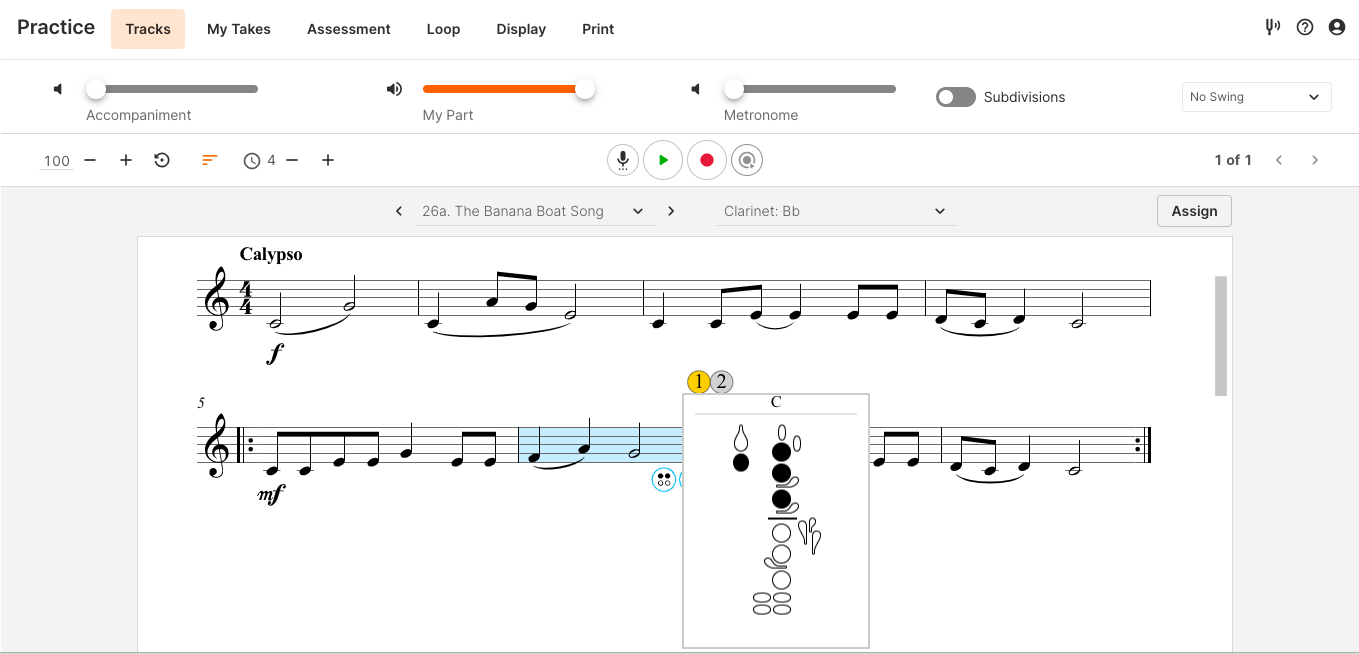
Alicia DeSoto & Chris Meredith are currently band directors at Lewisville High School in Lewisville ISD, TX.
Literacy: the ability to read and write
Music Literacy: the ability to read, write, and play music
What can we do as music educators to develop music literacy in our classrooms, with the same level of detail and care that elementary school teachers pour into their young readers and writers? It’s so easy as band directors to accidentally narrow our scope to get from concert to concert, and miss the opportunities to isolate the fundamentals of literacy. Are we in a short term rush to play as many songs as possible now, or are we taking our time to set up our students to read more advanced literature down the line? Are we afraid that students will be bored with literacy exercises?
Shouldn’t we be more afraid that students will get frustrated when they reach a reading ceiling?
We are going to discuss the foundations of music literacy and strategies we’ve used with our students at both the beginner and advanced levels to isolate these layers in order to produce higher levels of student achievement and mastery. To quote Daniel Kohut: “Teach one thing at a time, and teach it thoroughly.” (Musical Performance, Kohut, 1985)
Note names
We have too often assumed that because our students can play their performance music well, that they must also be reading the note names well. But let’s be honest, they are really only sight-reading the note names the first time they look at it, and after that they are starting to memorize patterns. A few years ago, we gave our second year band students a note name sheet to fill out on the first day of school after summer break, mostly just to give them a quick activity for the beginning of class while we were taking care of first day logistics. We were shocked to find how many students had forgotten a few notes over the summer, which made us question how well they really knew the notes before summer break. What used to be a few note name sheets at the beginning of the beginner band year quickly turned into weekly note name sheets for the entire year, plus more reinforcement with our older students.
While computer and phone note name apps and games can be a ton of fun, we have found that good old fashioned paper and pencil note name worksheets are the most effective way to provide assessment feedback to students. A screenshot of a percentage score from an app doesn’t tell the teacher that the student simply needs help switching the note name for the ledger line above the staff with the ledger line below the staff.
Develop or curate a collection of note name sheets that very carefully progress through a range development sequence appropriate for each instrument. Students should come across all new notes in a worksheet before needing to read the new note and play the new note at the same time in a song or exercise.
At the beginning of class each Monday, we have a worksheet with about 30 notes on it waiting on each chair. Students fill it out immediately and then move on to their rhythm activity. If you have some teaching helpers in your class, you could grade the sheets immediately and pass them back so you can talk to students who need a little help. If you don’t have the opportunity to grade the sheets in class, try to grade them before the school day is over so you can put the sheets in the student’s instrument cubbies to grab at the end of the day.
At the beginning of class each Tuesday, students again have a note name sheet waiting on their chair. Same note names as Monday, but in a different order, and likely only 20 notes instead of 30. If a student receives a 100 on Tuesday, they are done with note name sheets for the rest of the week. If they have any mistakes on Tuesday, they will continue to retake the sheet every day until they earn a 100. By Friday, if the student still isn’t receiving a 100, they might need an easier set of notes to match their current skill set. Side note—we only give 100s on these assignments. If a student misses a note on a sheet, they are provided with the correct answer, and no score is written on top.
We have started using more challenging note name sheets with our more advanced students to reinforce key signatures and rules about accidentals. Ever wonder why your low brass students keep playing A natural instead of A flat? Give them a note name sheet with an A flat in the key signature! Ever get frustrated that your students keep forgetting that the D# at the beginning of the measure carries through to the D at the end of the measure? Give them note name sheets with accidentals that carry through!
Vary up the rhythms on the note name sheets too; the note head on the F line looks different when it’s shaped like a whole note verses shaped like a sixteenth note. Now imagine that the sixteenth note of the F line was formatted in a jazz font, or a handwritten manuscript font! There are so many ways to vary up these note name sheet activities.
When learning a new song in class, one of the very first things we do is touch each note head on the page and say the note names in order. Then we can say the note names in order again and finger along on our instruments. This will guarantee that students are really reading the staff, and not just associating the symbols with the fingerings.
Another reinforcement of note names is through our scale learning process. Even when we have our students combined in a heterogeneous group, we will often learn the scales all together, NOT in concert pitch transposition. For example, every single student, regardless of transposition, will learn their D scale. You might think this is crazy, but hear us out. For this step of the process, we value learning the correct notes in the scale over ensemble intonation. This lets every student say the note names together, and really enforce which notes are sharp, flat, etc. Every student can say the note names and finger along together.
Students can click “Play” on a piece of music that they are playing in MakeMusic Cloud (SmartMusic), and say the note names as the blue tracking bar moves left to right. If they are unsure of a note name, they can simply click on the note, and the note name and fingering will appear. This is a great resource for students to use as a full class and also when practicing at home. Teaching students that one of the first steps to learning a piece of music is to say all of the note names out loud will be a very useful tool as students start exploring music and learning on their own.
We continue checking, assessing, and reinforcing note names with our older students as well. For example, we passed out an extra copy of the All-Region audition etudes to our high school students, had them quickly write in all of the note names, and then turn the music back in. This helped to clear up any confusion with accidentals and key signatures before the students accidentally learned a finger pattern incorrectly.

Rhythm
Rhythm reading is the single strongest indicator to predict sight-reading performance success. If we want to infuse confidence in our students to be independent music readers, then we must provide ample opportunities for them to develop the ability to read rhythms and apply it in a practical way toward performing on their instrument.
Practical rhythm reading development through performance
Step 1: Clap and count! Without the instrument, perform rhythms through clapping and counting to internalize subdivision and practically apply rhythm reading without stressing about tone, hand position, and posture. Have the student count out loud the subdivision for each measure while they clap the rhythm. Continue counting through rests because we are teaching performers to always have the subdivision actively present during sound and silence. Students will demonstrate note length by holding their hands together for the duration of the rhythmic value and separate their hands back open when the note should release. Students aren’t just clapping the start of each note, but also the length of each note.
Step 2: Play on one note or on a small part of their instrument! Next by playing the rhythm on a small part of the instrument we can help reinforce successful rhythm performance by prioritizing focus on the rhythm reading while only having to add a simple layer of the instrument.
Recommended ways of performing on the small part of the instrument:
- Flute: Open head joint, should make a pitch of Concert A
- Oboe and bassoon: Just on the reeds (no specific pitch) or bassoon with reed and bocal should make a pitch of concert C#
- Clarinet: Mouthpiece and barrel, should make a pitch of concert F#
- Alto saxophone: Mouthpiece and neck, should make a pitch of concert G#
- Note: By having all the woodwinds students perform rhythms on the smaller part of their instrument, embouchure, articulation, and air can be detailed without the mask of the instrument. If students can consistently articulate their rhythms on these pitches, they will have a very stable pitch and tone center on the whole instrument.
- Brass: Mouthpiece with articulated air stream (embouchure muscles are set, but center of lips do not touch to create a vibration: avoid too much time with lip vibrations with beginners as it can lead to the development of bad habits including tightness and unsupported air). Articulated air allows the teacher and performer to clearly hear the energy in the air and tongue placement.
Practical rhythm reading development for a specific piece of music
Isolate three to five challenging rhythmic phrases in a new piece of music that students will need to work on independently to master their part. Keep each rhythmic phrase between one and three measures long to maximize focus on the specific segment.
Assign the piece in MakeMusic Cloud (SmartMusic) with instructions describing exactly which measures to practice slowly through:
- Clapping & counting
- Small part of the instrument
- One note on the instrument
- Perform as written!
For even better results, create your own curated rhythm sheet that draws from challenging rhythms throughout the piece (from all instrument parts!) and pass out the sheet to the entire band so everyone can learn all of the fun rhythms together. This will allow you to break down rhythms quickly with the entire band and gives some instruments a chance to play more interesting rhythms than they may otherwise. Plus, if the goal during rehearsal is for everyone to learn everyone else’s part to understand how each part fits together, then understanding all of the complicated rhythms that are presented throughout the piece will ultimately provide everyone with more awareness of those connections between parts.
Many band method books include a few pages of rhythm studies that can easily be accessed in MakeMusic Cloud to work on isolated rhythm reading.
- Essential Elements, Book 1, Rhythm Studies
- Habits of a Successful Middle School Musician, Rhythm Vocabulary
- Standard of Excellence Band Book 1, Rhythm Studies
- Tradition of Excellence, Rhythm Studies

Recap
Trust the process! By separating these literacy skills into different segments, it may seem that your students are playing less music in class because they are spending more time working on note name, rhythm, articulation/style, and dynamic activities. Teaching and assessing only one thing at a time will give students the skills they need so that when they do work on music, they are able to put it together much faster and more accurately. This will propel students past the printed stuff on the page and into the elements that aren’t written down, such as tuning, tone, balance, etc. Get the students to read with their eyes so effectively that their brain is able to shift to the gear that uses their ears—where the real music making happens.
In part 2, we’ll cover style, articulation, and dynamics.
Recharge, Rebuild, and Reinvigorate with More Power Up Blogs

Alicia DeSoto serves as Associate Director of Bands at Lewisville High School in Lewisville, Texas. Mrs. DeSoto earned her undergraduate degree from the University of North Texas, and her Master of Music in Music Education degree from Southern Methodist University. She is an active guest clinician, lecturer, and adjudicator and has professional affiliations with the Texas Bandmasters Association, Texas Music Educators Association, and Texas Music Adjudicators Association. She currently serves as the TMEA Region 2 Vice President. Current projects include the Musical Mastery Beginner Band series with Asa Burk, Kathy Johnson, Chris Meredith, and Dominic Talanca. As the chief editor for Musical Mastery, Mrs. DeSoto has enjoyed the opportunity to compile an instrument-specific beginner curriculum to share with thousands of students throughout the country.
 Chris Meredith is currently the Director of Bands at Lewisville High School in Lewisville, Texas. Prior to his position at Lewisville, Mr. Meredith served as Director of Bands at Shadow Ridge Middle School in Flower Mound, Texas for thirteen years. He holds a Bachelor’s degree in Music Education from the University of North Texas and a graduate degree in Music Education from Southern Methodist University. Meredith is an active adjudicator, author, guest clinician, and lecturer, and is honored to have professional affiliations with Texas Bandmasters Association, Texas Music Educators Association, Texas Music Adjudicators Association, and Phi Beta Mu. Current projects include the Musical Mastery educational band series with Asa Burk, Alicia DeSoto, Kathy Johnson, and Dominic Talanca.
Chris Meredith is currently the Director of Bands at Lewisville High School in Lewisville, Texas. Prior to his position at Lewisville, Mr. Meredith served as Director of Bands at Shadow Ridge Middle School in Flower Mound, Texas for thirteen years. He holds a Bachelor’s degree in Music Education from the University of North Texas and a graduate degree in Music Education from Southern Methodist University. Meredith is an active adjudicator, author, guest clinician, and lecturer, and is honored to have professional affiliations with Texas Bandmasters Association, Texas Music Educators Association, Texas Music Adjudicators Association, and Phi Beta Mu. Current projects include the Musical Mastery educational band series with Asa Burk, Alicia DeSoto, Kathy Johnson, and Dominic Talanca.